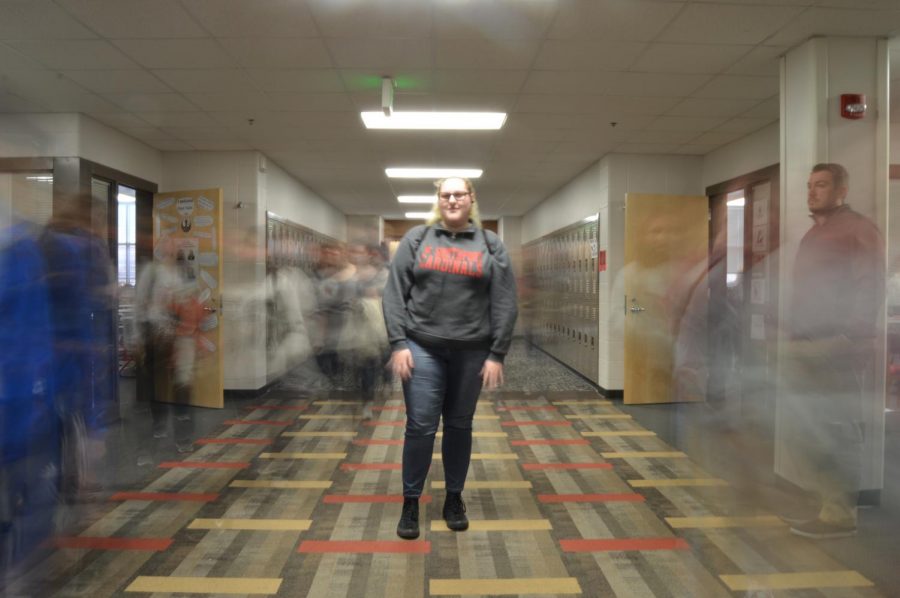‘Cycle of madness’
Studies find rise in depression and anxiety among teens today
Sophomore Kelly Alte
EVERYDAY WITH A MENTAL ILLNESS
Some days, when her phone alarm blares a signal to get up and start a new day, sophomore Kellie Alte wishes that she never heard the alarm, wishes that she never woke up.
“I think there might be a future, and I’m hoping I reach that, but as far as I’m seeing now, my mind isn’t letting me venture into the possibilities I can reach,” Alte said. “That’s the one of the hard parts because I want to overcome it, but then there’s those moments when I’m falling back into my depression, and it’s like, ‘I don’t care anymore.’ I let it control me. It’s not my problem.”
Reasons like these are why Alte and other teens who have depression, anxiety or similar mental health conditions often feel suicidal and or depressed. They don’t want to have to shut the alarm off. They’d rather have it not go off at all. Statistics show that the number of teens afflicted with mental illnesses has risen in the past decade, but Alte doesn’t want to be another statistic.
Often, negative thoughts are on Alte’s mind and things stick with her because of her anxiety. She recalls events like conversations, online or off, in which people tell her that she should stop eating or that her body is gorgeous. It was the bullying and conflicting statements that encouraged her to compare and contrast herself to others, whether she liked it or not, because of the impact the words had.
“As technology grew, the worse problems got,” Alte said, “because it introduced cyberbullying and it wasn’t just now you go to school, and that’s… where the bullies were,” Alte said. “You’d go online too, that’s where more people were because that’s where (the bullying) is non-stop… it was like a cycle of madness.”
Her parents have depression as well, so part of her mental health conditions could be hereditary, Alte says. Therapist Abigail Shwars says that in psychology there are some disorders that people are vulnerable to developing, but not necessarily meaning that they will develop it. This is called genetic vulnerability.
Genetic vulnerability ties into the idea of “nature versus nurture” that Shwars says can apply to just about anything in psychology. Nature implies that one is born with chemicals in the brain that may or may not be the roots of the disorders and nurture meaning that the environment the person is put into could potentially further or trigger an underlying disorder. So, Alte’s origin of depression could be a mixture of both biological and situational ties.
Her mind pushes her to compare because of how she’s wired and being taller and bigger in size compared to her friends increases her insecurity and has driven her into depression, bulimia and self-harm, she says. When technology appeared in the picture for the first time, when she got a smartphone in the sixth grade, Alte said the feelings of a negative body image weighed even heavier.
Pressured by the standards of models or workout programs that she barely paid attention to before, she feels she formed a hatred of herself when external factors combined with her inner thoughts such as her anxieties and comparisons formed by it.
The anxiety and depression she faced was only kept among herself, her friend group and the therapy sessions she attended. She couldn’t stop shutting herself off from people, whether that be from depression affecting her mood or anxiety affecting her willingness to be around large numbers of people. Alte thinks that anxiety may be present in other people, although she feels it is rarely talked about due to the stigma around it.
The Journal conducted a voluntary, anonymous survey in an AP class asking students to rate their anxiety levels on a scale of 1 to 10, one being low and 10 being high. Eight out of the 15 responses were on the high end of 7-10, while three were on the low end of 1-2.5. Alte rated her’s as a 6, showing that she is not completely alone, even though her mind can be the one who’s bullying her into thinking that is the case.
CAUSES OF MENTAL ILLNESSES
As Alte stepped onto the performance floor at her first color guard competition freshman year, a panic set in. Intrusive thoughts were running through her head telling her that she was being stared. She couldn’t calm her anxieties, but the show had already started. All that she could do now was make it through and hope that she wouldn’t succumb to the negative thoughts.
“Whenever I try to do things out in the open, I’m more secluded,” Alte said, “… when I did color guard it was hard on me because I was like, ‘Oh yeah, I’m not as good as them,’ and I was tall, I stood out. I was like, ‘Well, people are going to focus on me because I’m the biggest one there.’”
At SHS, students, like Alte, with mental health issues should not feel as if they have nowhere to turn to or that they are alone, says SHS social worker Jorie DePalma. Shwars says that there are reasons behind someone’s mental health issues and it’s not their fault, it’s the atmosphere, technology advancements, genetics and numerous other factors that can lead to these disorders.
A “Time” article pointed out teens crave stimulation and the biggest thing that is going to affect them is the social climate they are in.
“They are the post 9/11 generation, raised in an era of economic and national insecurity… and, perhaps most importantly, they hit puberty at a time when technology and social media were transforming society,” the article claimed.
In the anonymous survey The Journal conducted, the students were asked to briefly explain their anxiety ratings. One person who rated theirs as a 2.5 wrote, “I think I manage to keep it low because I know how to keep my schedule manageable with plenty of breaks so I’m not too tired. Gotta learn quick with 4+ AP classes.” Someone who rated theirs as a 4 wrote, “I keep myself busy with sports and social stuff to balance it out, but when I’m alone I start to overthink, and that’s where anxiety kicks in.” One person who rated theirs as a 10 wrote, “The stress of grades/end of the semester, extracurricular activities, college/scholarships, tests/ISTEP/SAT, time (not having enough of it),” caused their anxiety.
“It seems, at least from the outside, that as the years go on, the stresses and academic requirements and extracurriculars and all of those things that are ‘required’ to get into whatever college you want to get into — it seems that it increases every year,” Shwars said.
These are the situational factors that could possibly be contributing to the rise in the mental illness, Shwars says. Or she says it could possibly be because society has more access to be able to see the numbers and do the studies to create articles that probe at the thought and facts of mental health getting worse.
HOW TO DEAL WITH MENTAL ILLNESSES
While working with students for 11 years, DePalma has seen numerous kids come in and out of her office seeking help. With the resources she has available, she helps these students who need it. All she needs from them is the ability to see their issue and the desire to get better.
“We’re really lucky to have teachers who really know their students…,” DePalma said. “I get emails from teachers all the time saying, ‘Can you just check in with this student because it seems like something’s going on, their mood has really changed. I get referrals all the time.”
DePalma says talking with any trusted adult at SHS can start a path towards students seeking help with their issues.
English teacher Sara Kohne says she isn’t an expert, but she’s seen the facts line up about mental health in students and believes that students can do little things to help themselves as well.
Telling teachers about their problems could aide students to maximize their ability to learn in the classroom, Kohne says. She’s had students who’ve come up to her and told her they have a certain disorder that would affect their learning, and that helped her better understand the student and what their needs were to succeed.
“I think it’s important (for) students, if they’re comfortable, communicating at least a minimum amount of what’s going on with them to their teachers. (It’s) not because (teachers) are nosy, but it’s because they care,” Kohne said.
This way, the student doesn’t have to suffer in class grade-wise or social-wise, but it takes courage to be able to do this, Kohne says. However, another option is emailing DePalma or going to her office during passing periods or after school. She cannot help in the classroom, but she can direct students and their parents towards resources that cater to their needs, like the Adult & Child services provided in the building, or recommend the student to take a mental health evaluation.
One way Alte has gotten helped since her diagnosis is taking medications and going to therapy. Although she has had instances where even that doesn’t help, and visits to the hospital became needed, it’s become a helpful thing.
“A lot of times when (therapists and doctors) tell me they’re really concerned about me, it’s strange because no one’s ever given me that time of day to explain myself,” Alte said.
Students don’t have to be diagnosed to feel like they have a certain disorder, Shwars says, so if the stresses of school, technology or other factors have piled up, students should talk to someone. DePalma believes any adult in the building is capable of getting them to the right place.
“It’s a scary thing to say, ‘I need help, I want somebody to help me,’” Shwars said. “t can really feel uncomfortable to go into a therapy room with a stranger and (lay) everything out there,’ but I would say ultimately if you can push yourself past that fear and discomfort and speak to somebody; whether that’s a therapist, a trusted teacher, a counselor at the school, anyone, then ultimately in the long run, it’s gonna get better and you’re going to feel better.”

Hi, my name’s Madison Gomez, this is my second year on staff and I'm an entertainment writer and copy chief. Copy chief, by the way, checks to make sure...












